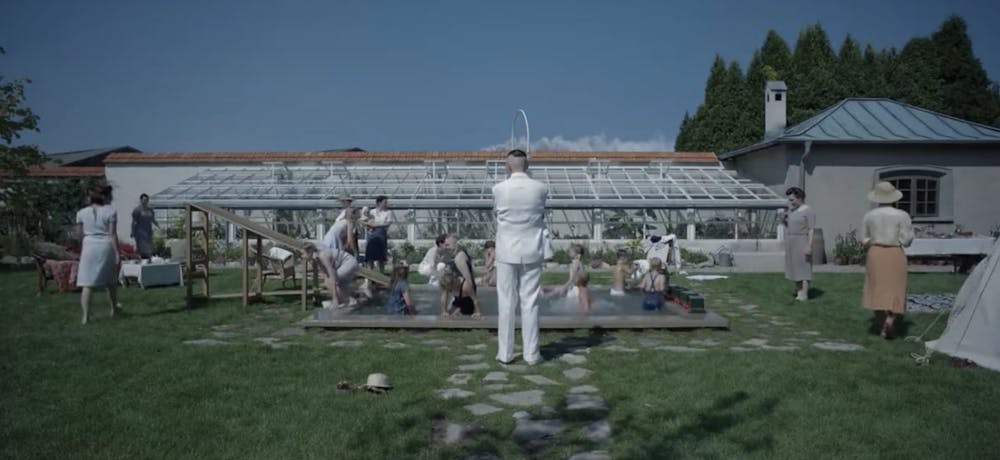Hedwig Höss (Sandra Hüller) discusses her love of her well-kept garden. The camera cuts between marigolds, sunflowers and roses, finally landing on a single hibiscus. Its red hue slowly envelopes the entirety of the screen. The silent beauty of the garden is overtaken by a droning, rumbling bass that is intermixed with anonymous suffering. The noise is that of the Auschwitz-Birkenau crematoriums. Hedwig’s husband, Rudolph (Christoph Friedel), is its commandant and their family lives on the other side of the camp’s walls.
Jonathan Glazer’s 2023 film, “The Zone of Interest,” is one of the ten nominees for the Academy Awards’ best picture and the prohibitive favorite for best international feature. If one were to squint and ignore all subtext, “The Zone of Interest” functions primarily as a family drama. Rudolph struggles with an occupational reassignment; Hedwig desires the best for her family and home; their children play in the backyard. The camera lingers and stiffens but doesn’t question. Functioning more as a voyeur than an interrogator, Glazer, director of the film, implicates the audience in the compartmentalization of the Hösses.
The joy of the Höss family is simply felt: their grass is green, their sky is clear and blue, and their faces are structured by smiles. The pain of the concentration camp is more difficult to confront: such unimaginable terror must be abstracted to be understood and felt. Any literal depiction of their torment would be grotesque and a disservice.
Structurally rhythmic and narratively sparse, Glazer attempts to anesthetize. In three similar sections, we see the members of the family go to school, go to work and take care of the house. They then arrive home to eat, play and love. Finally, we see their battle with the darkness of night.
It is in this last portion of the day that Glazer withdraws the anesthetic, turns up the volume and monochromatizes the screen. In a decidedly silent and diegetic film, Glazer shifts all visual focus to auditory. The pain that is so comfortably hidden by barbed wall belts seeps through its confines, past the consciousnesses of the Höss family, directly into the audience.
It is these breaks in structure that allow the audience to feel what the Höss family ignores. It is the contentedness that their life offers — their gain from fascist genocide — that allows them to forget.
The walls of the camp (and the Höss’ home) act as a metaphor for the mental walls constructed by the family to separate their idyllic life and what must happen for its continuation. The camera’s incessant distance from the family parallels the distance between understanding and reality, desire and consequence.
In the only other departure from the silence of willful ignorance, a young girl, also living next to the walls of the concentration camp, places fruit under shovels and wheelbarrows of camp laborers. As she places a pear, she reaches down to see a box containing a folded paper containing a music score, presumably written by a prisoner. She returns home and plays the piece (beautifully and ironically entitled “Sunbeam”) discordantly, learning the notes as she plays them.
The auditory undercutting of the visuals of “The Zone of Interest” doubles as Glazer’s self-realized inability to depict the horrors of the Holocaust. In a scene that mirrors the ending of this year’s “Killers of the Flower Moon,” Glazer removes the audience from the story and places us inside the present-day Auschwitz-Birkenau, which serves as a memorial and museum. We see the museum’s janitorial crew clean the crematories and exhibits with a similar indifference to that of the Höss family.
Glazer appears to argue through the film that the human condition is equally incapable of worship and demonization. Filled with the best intentions, the staff of the museum, the museum itself and this film, stand as a noble, yet trivial, manifestation of reverence. The choice by Glazer to make a Holocaust film about the family of one its most infamous orchestrators, rather than its victims, is as much a recognition of his inability to engage with the realities of Auschwitz as the Höss’ escape into their garden and playground pool. This metatextual understanding and the ending’s projection into the present day expand the critique of the Hösses beyond World War II-era Germany. “The Zone of Interest” offers itself as a parable of the faults that plague us — a film as much about today as 1943.
Get The Chronicle straight to your inbox
Sign up for our weekly newsletter. Cancel at any time.
Kadin Purath is a Trinity junior and a culture editor for Recess.

